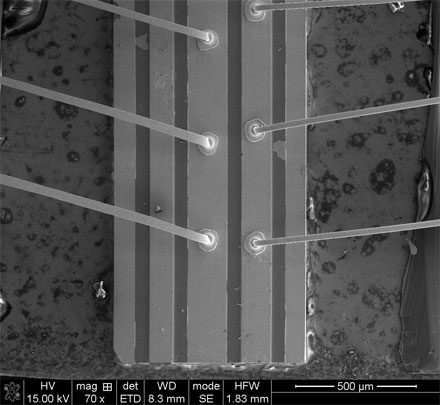
Terahertz QCL Demonstrates Record Power in CW Mode
source:photonics.com
keywords: Laser QCL terahertz radiation
Time:2016-07-29
The output power of a terahertz quantum cascade laser (QCL) has been effectively doubled, producing record output power of up to 230 mW in CW mode, compared to the previous record was 138 mW.

A scanning electron microscope image of the terahertz quantum cascade laser.
A team from the Institute of Applied Physics and Computation Mathematics and the China Academy of Engineering Physics, led by researcher Xuemin Wang, reported the results, and attributed the higher output power to the material growth and manufacturing processes they used. QCLs are made from thin layers of material, which enables tuning of the emitted wavelength.
The researchers reported a 2.9-mm-long device operating at 3.11 THz with a low threshold current density of 270 A/cm2 at about 15 K, developed using a hybrid bound-to-continuum transition and resonant phonon extraction design. The maximum operating temperature was about 65 K in CW mode, and the internal quantum efficiencies decreased from 0.53 to 0.19 for the devices with different cavity lengths. By using one convex lens with the effective focal length of 13 mm, the beam profile was collimated for a quasi-Gaussian distribution.
The output power increase demonstrates that the team's method of controlling the growth of the laser's layers can increase output power, Wang said, and he is hopeful that future improvements could bring the continuous power above 1 W, which thus far has only been produced in terahertz QCLs operating in pulsed wave mode. A hybrid bound-to-continuum transition and resonant phonon extraction design was used.
The unique qualities of terahertz radiation make it an attractive candidate for imaging, but the ability to produce and control terahertz waves has lagged behind technology for radio, microwave and visible light. Wang believes the new laser could become a flexible source of terahertz radiation for spectroscopy, medical imaging, remote sensing and other applications.
MOST READ
- RoboSense is to Produce the First Chinese Multi-beam LiDAR
- China is to Accelerate the Development of Laser Hardening Application
- Han’s Laser Buys Canadian Fiber Specialist CorActive
- SPI Lasers continues it expansion in China, appointing a dedicated Sales Director
- Laser Coating Removal Robot for Aircraft
PRODUCTS
 FISBA exhibits Customized Solutions for Minimally Invasive Medical Endoscopic Devices at COMPAMED in
FISBA exhibits Customized Solutions for Minimally Invasive Medical Endoscopic Devices at COMPAMED in New Active Alignment System for the Coupling of Photonic Structures to Fiber Arrays
New Active Alignment System for the Coupling of Photonic Structures to Fiber Arrays A new industrial compression module by Amplitude
A new industrial compression module by Amplitude Menhir Photonics Introduces the MENHIR-1550 The Industry's First Turnkey Femtosecond Laser of
Menhir Photonics Introduces the MENHIR-1550 The Industry's First Turnkey Femtosecond Laser of Shenzhen DNE Laser introduced new generation D-FAST cutting machine (12000 W)
more>>
Shenzhen DNE Laser introduced new generation D-FAST cutting machine (12000 W)
more>>
